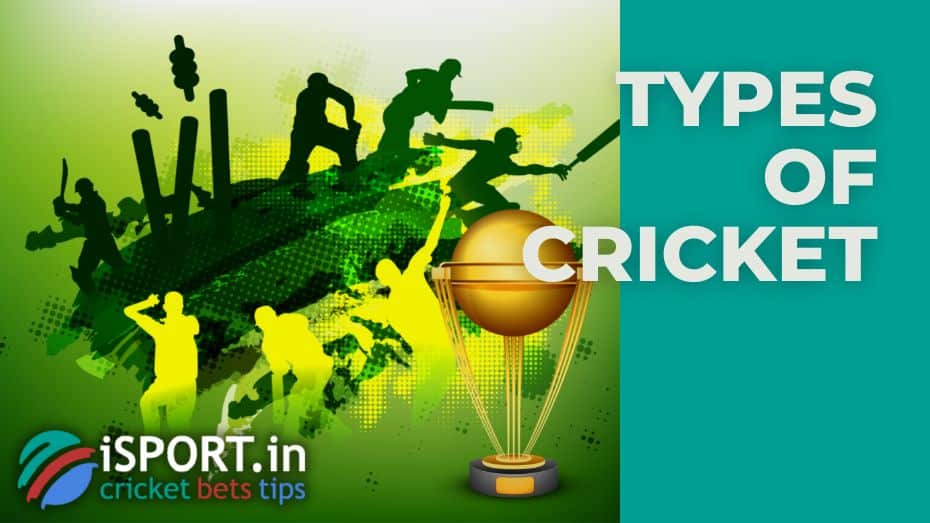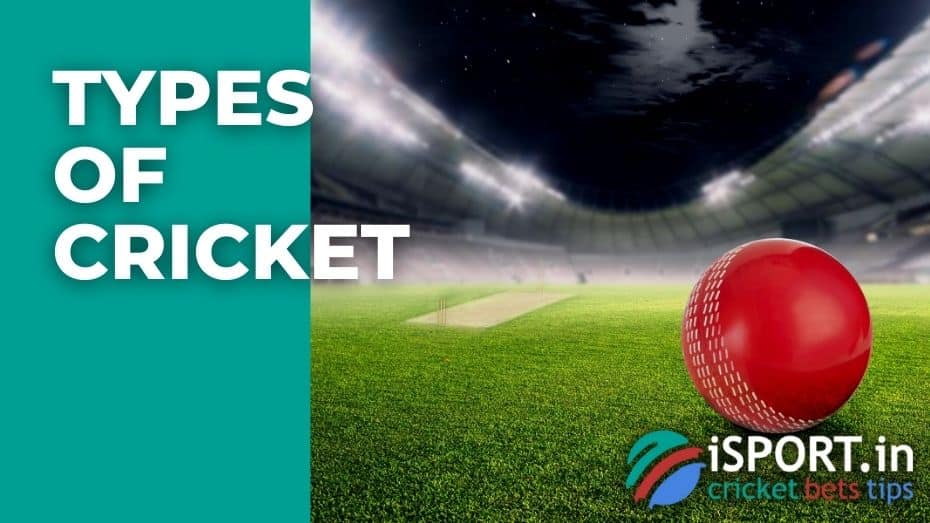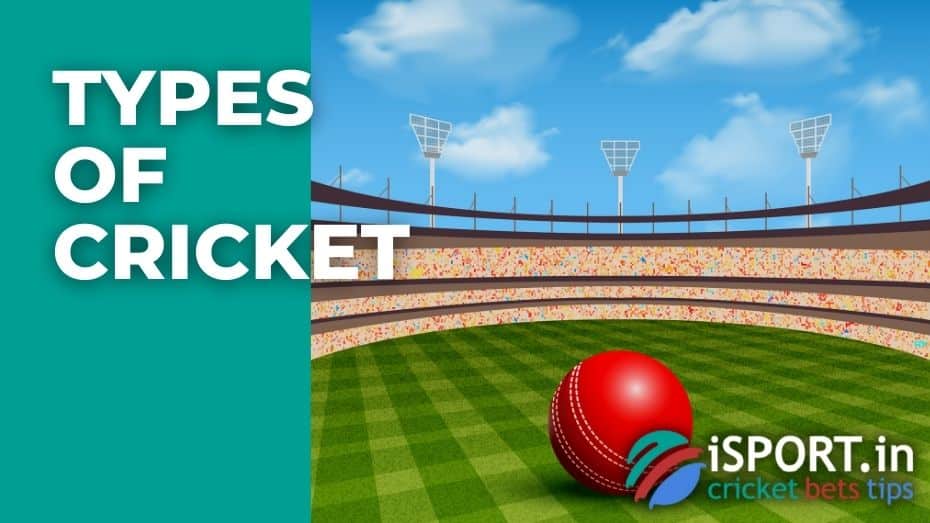Types of Cricket
Types of Cricket - overview

Cricket is a popular, amazing and exciting sport. Hundreds of millions of people around the world follow and play cricket. The main competitions are divided into three types: first-class (held over several days), one-day (with a limited number of overs) and short matches. The games are held both at the international and national levels. There is men’s and women’s cricket. In addition to the basic types, each playing country has its own non-standard rules and types. By the way, did you know that cricket is also played indoors? In this article, we will try to understand all the game types of cricket.
Types of cricket – overview
In general, cricket is divided into two groups: professional and amateur. In turn, professional cricket consists of international and domestic draws. At the amateur level, they play only within the country. For convenience, we will make a list of all the formats of professional cricket and then briefly describe each of them:
- First-class cricket.
- Test Cricket (international matches);
- Top-level national matches.
- One-day cricket (List A).
- One Day International;
- Domestic one-day matches.
- Twenty20 cricket.
- International short competitions;
- Internal draws of short matches.
The governing body of cricket is the International Cricket Council (ICC). It was formed in 1909 by representatives of 3 countries: England, Australia and South Africa. Today, the ICC consists of 104 participating countries, 12 of which are full members (can play in test matches), and 92 states have the status of associate members.
The International Council is responsible for organizing and managing major international championships (the World Cup and the ICC T20 World Cup). It is important to know that the ICC does not control international test matches between 92 countries, nor does it regulate all domestic championships. To do this, each country has its own national cricket Associations. The most important feature: The International Cricket Council does not establish or change the Laws of the game, which were first invented in 1788 by the English club Marylebone. Today, this team is primarily responsible for all changes in the Laws of Cricket.
Types of cricket – First-class cricket
First-class cricket is the official name of top-level international and national matches. This type of cricket is considered the pinnacle of the sport, as its matches last for several days. We mentioned above that first-class cricket is divided into test (international) and domestic. The rules in these competitions are almost the same.
Test cricket is the oldest form of cricket. It is an international sport where the games last at least three game days. To date, only 12 national teams are eligible to play in the Test Cricket Championship:
- Australia (joined in 1909);
- England (1909);
- South Africa (1909);
- The West Indies (1926);
- New Zealand (1926);
- India (1926);
- Pakistan (1952);
- Sri Lanka (1981);
- Zimbabwe (1992);
- Bangladesh (2000);
- Ireland (2017);
- Afghanistan (2017).
One match between 2 national teams can last up to 5 days. By tradition, all members of the national team must be dressed in white uniforms. The ball must be red. One game consists of 4 innings. The number of overs in one inning is unlimited, but at least 90 of them must be. On average, one game day consists of three periods, each played for two hours. There are 40 minutes for lunch and 20 minutes for tea between sessions. The winner of the meeting is the team that has scored the most points in total for all the days. According to official statistics for May 2021, India in this form is located on the 1st line of the world ranking.
First-class cricket is not only called international matches. To be honest, it has historically happened that first-class matches began to be called domestic competitions in the country. And only international ones are test ones (although there are first-class test ones). Cricket fans share them to avoid confusion between games.
The rules of international and domestic first-class cricket are the same. By the way, a first-class championship is called a tournament only in 12 countries that are full members of the ICC. Of course, other countries can hold their long-term matches, but they will not be called first-class!

Types of cricket – One-day cricket
One-day matches are professional international and domestic cricket championships that consist of a limited number of overs. The games are held within one day. Since 2006, the International Cricket Council has officially classified one-day cricket in a category called List A. List A includes one-day international matches (ODI) and various domestic competitions in which a limited number of overs varies from 40 to 60 (but usually 50 per innings). A total of two innings are played per match. We should add that although the matches are called one-day matches, they are often allocated two game days (the 2nd reserve). This is mainly due to the possible deterioration of the weather.
The international one-day game first appeared in the 1970s. The debut match was played in 1971 between the national teams of Australia and England. One of the main cricket tournaments, the ICC World Cup, is held in the ODI format. The first World Cup draw was held in 1975. The championship is organized every four years. For 46 years, the number of participants and the selection rule have constantly been changing. The modern ODI format includes a qualification period held for three years before the main stage of the championship. The next World Cup will be held in 2023, and a new selection method was invented for it. For more information, read a separate article about one-day matches. By the way, as of May this year, the New Zealand national team occupies 1st place in the official ODI rating.
One-day matches within the country are the same games with a limited number of overs (mostly 50). Domestic limited-overs matches are also classified as List A matches. To be honest, cricket fans like these matches more than first-class ones. Naturally, this is due to a smaller amount of playing time (maximum 8 hours). Thus, the players do not save their strength (unlike long matches) and play with all their might while showing a spectacular game!
Each country has its own specific one-day championships. For example, in Australia, this is a One-Day Cup – a single round-robin system (among 6 teams), then a championship final between the two best clubs. And in South Africa, six teams also took part in the 2020-2021 season, but their organization is different – two groups of 3 teams, two teams come out of each group, which play the title of a champion among themselves. By the way, since this year, the format of cricket in South Africa has changed dramatically.
Types of Cricket – Twenty20
The Twenty20 format is the youngest and most exciting game form in cricket. Also, the games are officially called matches with a limited number of overs, but unlike one-day matches (where there are 40 to 60 overs per innings), in T20, there will be only 20 overs per innings. Twenty20 Matches last a maximum of three hours, including a 10-minute break. And yes, such games do not belong to the A-List category!
Twenty20 International games are short international matches that appeared only in 2004. The main competition of shortened matches is the ICC World T20 Championship. There are 16 teams participating in the tournament: 10 are selected from the Twenty20 ranking, and 6 more are qualified. The championship is held every two years, except for the year when it coincides with the ODI World Cup. In this case, short matches are held a year earlier. To date, the best team for the Twenty20 games is the England national team.
The domestic T20 competition is a very popular championship in every playing country. It comes to the point that short matches overtake first-class cricket, as, for example, it happens in India! Created in 2008, the Indian Premier League is the most viewed and popular league in the country.
Why are short matches so popular? The thing is that the number of throws and strikes is limited, so every player wants to give everything to the maximum. And from this, aggressive, risky and spectacular throws and strikes appear. Also, the viewer is sure that the match will end today, and not in 5 days.

Types of cricket – the history of other types
T10 cricket is a shortened form of cricket that is limited to a maximum of 10 overs. This game lasts only 90 minutes. T10 is a new format, and it has been played only since 2017. The first competition was held in the UAE. By the way, the International Cricket Council has officially approved the league. And in 2020, there was talk about including T10 in the Olympic sport.
One-wicket cricket is probably the oldest version of cricket because there is no need for a team; only 2 people are enough. In our time, a very similar draw was held (in Dubai at the end of 2020). The format is otherwise called one-vs-one cricket. Two players take turns throwing 15 pitches to each other. Such a game was held indoors for obvious reasons.
Three-team cricket is a new, experimental format. The debut draw was held as an exhibition match in 2020. The competition was called the 3TC Solidarity Cup. The game was played between 3 teams of 8 players each. One team has only 12 overs (6 for one and 6 for the second team). The club that scores the most points wins. How will three teams play on the field at once? Everything is easy. There can be a maximum of two clubs on the field. The players from the third team are just waiting for their turn.
Amateur cricket – oddly enough, the three formats listed above are not considered an amateur sport. Amateur cricket is a very popular format. One of the types of this game is club cricket. Of course, all Laws are observed, but the formats are completely different.
Club cricket is played mainly on weekends or in the evening. Saturday cricket is the most serious format of amateur cricket. This is a competition with a limited number of overs (from 40 to 60) for each team. In addition to the main points, bonus points are also awarded for various merits.
Friendly cricket is played on Sundays. Here, games can already take place not only in limited overs (from 80 to 120), but also in time. This type of cricket is also very popular.
Evening cricket is just a formal game in the form of Twenty20. These draws are created for new players who are starting to get acquainted with the game of cricket.
Indoor cricket is a format of the game mainly intended for the winter period or a limited number of people. Matches are played with a hard ball. Two teams of six players participate. A maximum of 12 overs is played. Each bowler can serve up to 3 overs. A batsman must leave the field if he has scored more than 25 runs. One of the important differences of such cricket is the walls and ceiling. According to the Laws, fielders have the right to catch the ball directly from the wall – this will be considered the end of the game for the batsman (provided that the ball did not touch the field or the roof before). Indoor cricket is very popular in the UK.
Table cricket is a miniature version of cricket designed for people with disabilities. Matches are held on special tables. At one end is a bowling machine, at the other a miniature player with a bat. The other two sides are covered with partitions, with the possibility of placing field players.
Blind cricket is a game for blind and visually impaired people. The natural difference is a ball consisting of ball bearings. When flying, it makes sounds so that players can focus on it. This format appeared in 1922, and since 1996 it has been regulated by the World Cricket Council for the Blind.
There are other non-standard types of cricket in the world. The variety is very large. Each nation can come up with its own special rules. By the way, women’s cricket is also very popular at the professional level. In 1958, the International Women’s Council was established, and in 2005 it merged with the ICC. Since then, the International Cricket Council has been responsible for men’s and women’s cricket.
